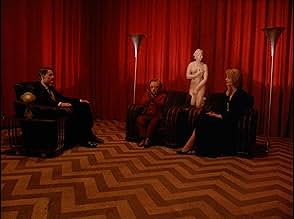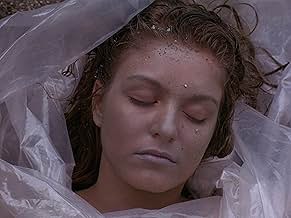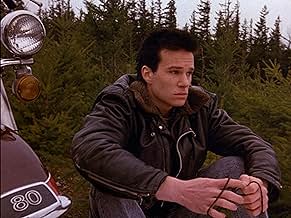Aggiungi una trama nella tua linguaAn FBI agent investigates the murder of a small town's homecoming queen. A self-contained, 20 minutes longer version of the pilot episode of I segreti di Twin Peaks (1990) and an alternate v... Leggi tuttoAn FBI agent investigates the murder of a small town's homecoming queen. A self-contained, 20 minutes longer version of the pilot episode of I segreti di Twin Peaks (1990) and an alternate version of I segreti di Twin Peaks (1990) that brings closure to the story.An FBI agent investigates the murder of a small town's homecoming queen. A self-contained, 20 minutes longer version of the pilot episode of I segreti di Twin Peaks (1990) and an alternate version of I segreti di Twin Peaks (1990) that brings closure to the story.
- Leo Johnson
- (as Eric Da Re)
Recensioni in evidenza
The narrative opens with the discovery of Laura Palmer's body, wrapped in plastic on the riverbank, setting off an investigation led by FBI Special Agent Dale Cooper (Kyle MacLachlan). The extended version deepens the sense of unease and surrealism through additional scenes that explore the town's quirky characters and strange rituals with more nuance. For example, the inclusion of scenes featuring the Log Lady (Catherine E. Coulson) and her cryptic warnings, as well as expanded interactions between Cooper and the local sheriff's department, enrich the world-building and heighten the eerie atmosphere.
One of the most striking additions is the extended sequence involving Sarah Palmer's (Grace Zabriskie) terrifying vision of the malevolent spirit BOB (Frank Silva) in Laura's room. This scene, with its raw emotional intensity and unsettling imagery, exemplifies Lynch's mastery of blending horror with psychological drama. The scream that follows is visceral and unforgettable, underscoring the trauma and supernatural menace that permeate the series.
Technically, the pilot showcases Lynch's cinematic sensibilities with meticulous cinematography by Peter Deming, whose use of shadow and light crafts an atmosphere both beautiful and ominous. The production design captures the small-town Americana aesthetic while subtly hinting at decay and darkness. Angelo Badalamenti's haunting score weaves seamlessly through the episode, reinforcing its dreamlike and suspenseful mood. The editing balances the procedural elements of the murder investigation with moments of surrealism and character-driven drama, maintaining a deliberate yet engaging pace.
The performances are uniformly strong, with MacLachlan's Cooper immediately establishing a charismatic and quirky presence that anchors the narrative. Michael Ontkean's Sheriff Truman provides a grounded counterpoint, while Mädchen Amick as Shelly Johnson and Lara Flynn Boyle as Donna Hayward add depth to the town's social fabric. The extended pilot also allows more time for secondary characters, such as James Hurley (James Marshall) and the enigmatic One-Armed Man (Al Strobel), to make a lasting impression.
Thematically, the pilot sets up Twin Peaks' exploration of duality, hidden darkness, and the uncanny. The town's picturesque facade conceals secrets of violence, betrayal, and supernatural evil, embodied in the figure of Laura Palmer and the spirit BOB. The episode's blending of genres-mystery, horror, soap opera, and surrealism-creates a unique tone that challenges conventional television storytelling and invites viewers into a layered, symbolic world.
Contextually, this extended pilot was initially released in select international markets and on home video before the American broadcast. Its longer runtime and additional scenes offer a different experience, sometimes described as an alternate reality version of Twin Peaks, with a more pronounced emphasis on the show's surreal and mythological elements. While some fans and critics prefer the tighter American edit for its narrative focus, the extended version is valued for its atmospheric richness and deeper immersion into Lynch's vision.
The production faced challenges typical of pioneering television projects, including balancing network demands with creative ambitions. Lynch and Frost navigated these tensions by crafting a pilot that could function both as a standalone film and as a series introduction. The extended pilot's inclusion of scenes that would later be reworked or omitted from the series reflects this dual purpose.
In conclusion, the extended 1989 Twin Peaks pilot is a vital piece of television history that encapsulates the innovative spirit and artistic daring of the series. Through Lynch's visionary direction, compelling performances, and a richly textured narrative, the episode invites viewers into a world where mystery and menace coexist beneath the surface of everyday life. It challenges and rewards audiences with its blend of genre, mood, and symbolism, setting the stage for a groundbreaking series that continues to influence television and popular culture.
Co-written & directed by David Lynch, this feature-length episode borrows elements from soap opera & detective fiction but presents it in a wicked, uncanny & offbeat way that the director is known for. The setup is quick, the tone & atmosphere has an unnatural feel to it, and character introductions are interesting to say the least, for almost everyone has some strangeness about them.
For the most part, it works as a perfectly good starting point to something a lot more promising but the alternate ending that brings closure to this narrative feels hurried & unearned. The only thing we get about its eccentric set of characters are first impressions which isn't enough for a satisfying conclusion. Performances vary from effortless to campy while Angelo Badalamenti's score stands out.
Overall, Twin Peaks features segments that strike an impression right away but the last 30 mins or so sways far from the road and ultimately fails to deliver the goods despite tying up the loose ends. I'm curious to find out what's different about the original pilot that leads to more episodes but there is enough in here to keep the audience invested in the mystery even if the ending feels rather underwhelming.
Lo sapevi?
- QuizThis is a self-contained, twenty minutes longer version of the pilot episode of I segreti di Twin Peaks (1990) that was initially released as a standalone video film for the European market. Some of the extra footage was later used for the dream sequence scene in Zen, or the Skill to Catch a Killer (1990). This alternate version of Northwest Passage (1989) brings closure to the Laura Palmer case and can also be considered as an alternate version of the series.
- Versioni alternativeThis is a self-contained, twenty minutes longer version of the pilot episode of I segreti di Twin Peaks (1990) that was initially released as a standalone video film for the European market. Some of the extra footage was later used for the dream sequence scene in the episode 2 of the series (which is the third episode overall: Zen, or the Skill to Catch a Killer (1990)).
- ConnessioniEdited from I segreti di Twin Peaks: Northwest Passage (1989)
I più visti
David Lynch's Movies Ranked by IMDb Rating
David Lynch's Movies Ranked by IMDb Rating
Dettagli
- Tempo di esecuzione1 ora 53 minuti
- Colore
- Proporzioni
- 1.33 : 1
Contribuisci a questa pagina







































